My thoughts on chant rhythm (and a few other things)
-
This is pretty off topic for a discussion on hymnals options, so I am starting a new thread.
In 1908, Pius X promulgated the Graduale Romanum without rhythmic signs which was a restoration (a cento to use Mr. Ostrowski's term) of the chant according to the equalist manuscripts of the middle ages. The earliest manuscripts have a large number of rhythmic indications, and show a completely different rhythm than the later equalist manuscripts (which Mr. Ostrowski will not admit, much to his discredit). So before the council of Trent we have at least two different rhythmic systems in use, to simplify it as much as possible. First we have manuscripts which show a varied and non equal rhythm. These manuscripts are fewer in number, but they were earlier. Then, as the staff begins to be used to show exact pitch, we have manuscripts which show an equal rhythm, which are much greater in number, but generally later.
Laon 239 (~880 AD), one of the earliest manuscripts, which shows a varied and non-equal rhythm:
12th Century manuscript, which shows an equal rhythm on four lined staff:
~1300 AD equalist manuscript, using square notes: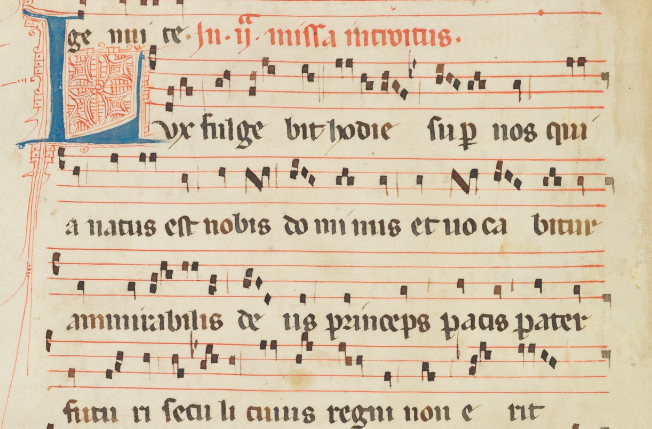
So here's the fundamental issue.
Dom Pothier compiled a cento of the equalist chant tradition of the late middle ages, but then Dom Mocquereau made changes to the rhythm which reflected some of the indications in the earlier manuscripts. Dom Pothier wasn't following the earlier manuscripts, he had made a very nice cento of the later equalist tradition, so Dom Mocquereau's changes messed up the chant by imposing foreign rhythmic indications on the equalist tradition. Consider the following: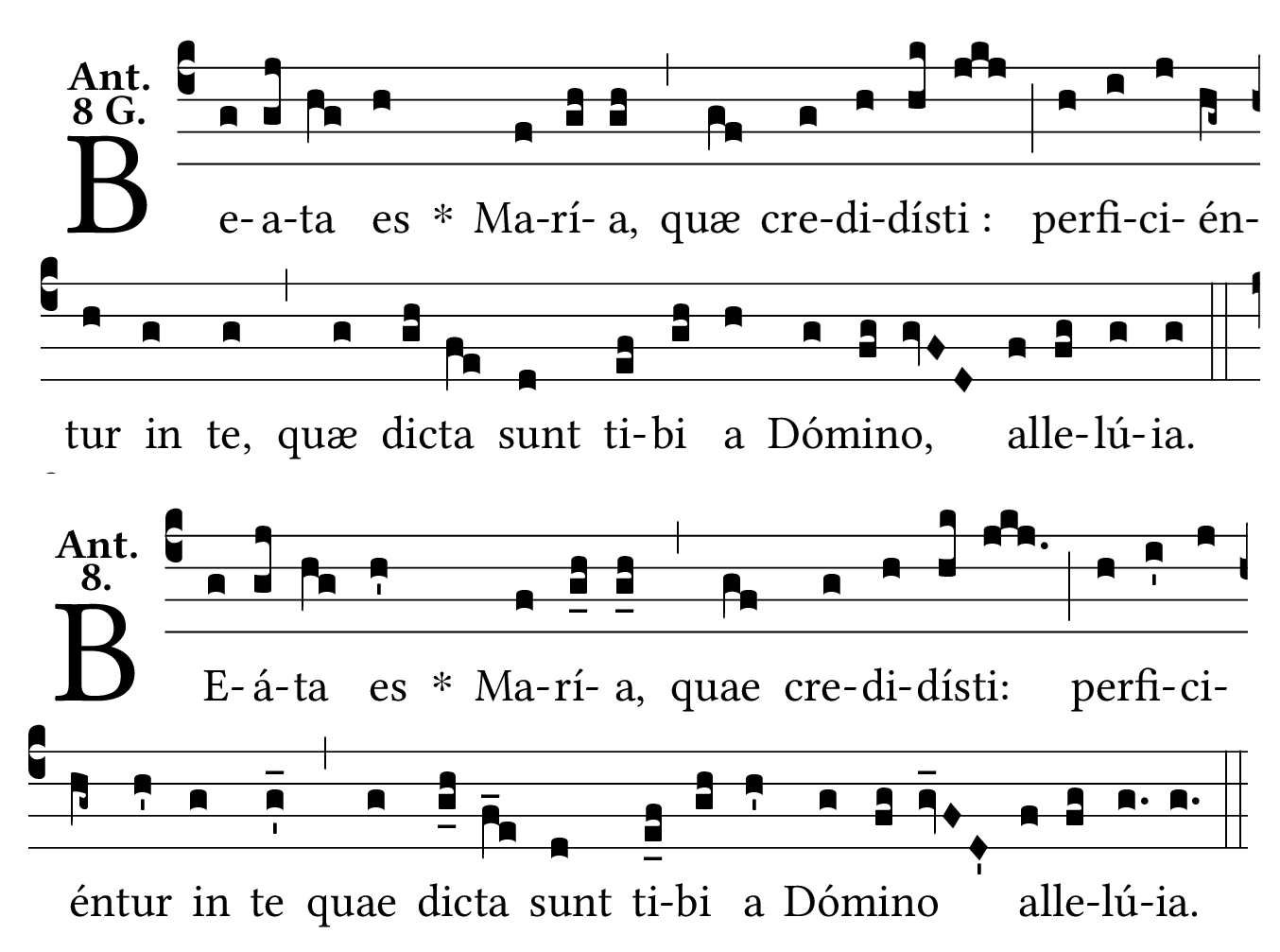
The rhythmic signs add several unnecessary lengthenings which slow down the chant. We are rather used to this, we have sung from the Solesmes editions for a long time, so it might seem normal to us, but when you actually think about it the extra lengthenings do not improve the chant in any way.
Consider the Advent IV Offertory Ave Maria. The LU gives a completely different rhythm than what Pius X promulgated. I made a recording of the Vatican Edition rhythm here. (forgive the poor quality!) I realize this is somewhat subjective, but I think the Vatican Edition of this Offertory is a lot simpler, more intuitive (once you remove the bias of what we are used to), and more beautiful.
I conclude that the "classic" Solesmes editions (such as the 1961 LU) are an unnatural hybrid of multiple traditions; and unnecessarily complicated (hence why the people who use it can't even all agree on how to perform it, say for example, how to render a horizontal episema, or what exactly the ictus means).
Now, I'm in no way attacking Dom Mocquereau or the people who made and use that system, I am merely attacking the system. This isn't about people, it's about ideas. Dom Mocquereau might have been a wonderful person, I can't say since I've never met him, but I give him the benefit of the doubt and assume that he was trying his best.
Regarding the oldest manuscripts, and the work of semiologists and mensuralists to interpret them, I think it's fine work, but we have no duty to necessarily follow the oldest sources. We have the duty of using the most appropriate music that we can. I believe that equalist chant, as found in the manuscripts from the late middle ages and the time of Thomas Aquinas, and restored by Dom Pothier and promulgated by Pius X, is the best that we have to offer to God right now, as well as the best for our own spiritual health. In his book "Good Music, Sacred Music, and Silence", Peter Kwasniewski makes very good points about how in today's culture, we need the gentle, flowing, free rhythm of chant now more than ever to counter the constant pounding of modern music and everyday life (it's been a while since I looked at it, so that's by no means a precise summery). I also agree with Peter Schubert's points about historically informed performance practice, which he puts very well here.
Obviously, it is extremely important that the singers are singing intelligently and fruitfully. To achieve this, they should be taught liturgical Latin, at least enough to be able to translate the Propers and other texts which they sing. The singers should contemplate the texts, and the time at rehearsals should be part spent singing the texts better, and part spent understanding the texts better. There is so much rich food for meditation in the chanted Propers and cycle of the liturgical year, that it is practically a crime for singers to meet each week only for the sake of improving their singing and not enriching their spiritual life.
Really, the barlines show the rhythm, as well as the dynamics. They mark the phrases, big, small, and medium, and then it is up to the singer to render those phrases properly, musically. Chant should be brisk but still musical.
That's my rant for now, maybe I'll think of more to add later.
Respectfully, I think that Jeff Ostrowski makes some ridiculous arguments, and that sometimes he is rather arrogant in his tone, but that nevertheless he is correct about certain things.
If I got historical information wrong (dates, etc.) let me know, and I will fix it. -
Fixed images.
-
St. Pius X himself wrote in 1912 that "It is important that these melodies should be performed in the manner that they were originally conceived as works of art." We know and can demonstrate that the chants of the Proper of the Mass were not conceived as equalist plainchant. As far as I can tell, this is almost universally accepted, with Ostrowski being possibly the last holdout. The deficiencies of the Vatican edition were admitted by Cardinal Merry del Val as early at 1906. A more critical edition was already in preparation at Solesmes in the 1940s.
Besides the rhythmic chant of the first millennium and the equalist plainchant of the High and Late Middle Ages, there was also cantus fractus, which certainly influenced the notation of the Medicaean edition. Accentualism in the form of pure liturgical recitative likely also existed, just as in the East, for the readings and priest's prayers. So, there were at least four rhythmic systems in use before Trent. Consider also that Luther's German versions of the pre-Reformation hymns weren't invented out of whole cloth. Their rhythm probably reflects what was already familiar at the time and place.
Having used the Solesmes method for 25 years and having now spent perhaps some 3,000 hours with the adiastematic neumes, I see no benefit to the equalist "pure Vatican" approach. If one is deliberately trying to replicate the sound of the High or Late Middle Ages, then it could be useful, but not at a "brisk" tempo as you advocate. I am convinced that a return to the oldest sources is the best way forward; the Church herself has called us to do exactly that. Yet, six decades later, the more critical edition called for by the council has yet to be officially promulgated. Will Cardinian semiology or mensuralism win out? A common critique of semiological performances is that they all sound different. Ostrowski is quick to point out that Cardine left no method. The problem with Cardine's semiology is that it not only retains but expands Mocquereau's theory of rhythmic nuances, despite shifting away from his idea about the independence of syllabic stress and the rhythmic ictus.
Although I continue to use the Solesmes method week in and week out, for the edition in preparation, my position remains that the oldest layer of the repertory and the newer chants derived directly from it should be sung rhythmically, with long and short notes in the same 2:1 proportion as quarter and eighth notes. The chant is characterized by a steady beat with occasional syncopation, but ternary groupings are absent; the rhythm is binary, and the tendency of short notes to be written in pairs or other even quantities can be observed throughout the manuscripts. The best and most thorough demonstration I can offer you is this recording of the chants for the Twenty-Third through Last Sundays after Pentecost/Thirty-Third Sunday in Ordinary Time:
I am happy to open these recordings up to discussion and criticism. They are not perfect, but is it not possible to transcribe the adiastematic nuemes from the rendition, exactly as they appear in Laon, Einsiedeln, and the St. Gall Cantatorium? That cannot be said for the equalism of the pure Vatican edition or the slight agogic nuances (many of which are lacking) of the Solesmes edition.
My Edition
Vatican Edition with Rhythmic Markings and Commentary (link fixed!)
You stated as "the fundamental issue" that "Dom Pothier compiled a cento of the equalist chant tradition of the late middle ages . . . he had made a very nice cento of the later equalist tradition, so Dom Mocquereau's changes messed up the chant by imposing foreign rhythmic indications on the equalist tradition." Your description of the Vatican edition as "a cento of the equalist chant tradition" implies that the rhythmic manuscripts were not taken into account in compiling the Vatican edition. Do you mean to make that argument and, if so, can you support it with evidence? -
Thanks for this beautifully illustrated post. This is a huge topic, and you can read some of my thoughts on the matter over at CCWatershed. Indeed, I owe Jeff a response to his most recent article, touching on this very subject. I find this question fascinating, as is the whole subject of chant rhythm.
I'm pretty new as a commenter on these forums, but since I've been reading for years, I know a lot of this ground has been covered before. Thanks for sharing your thoughts and for making such a nice, solid, succinct argument for the equalist style.
If I might suggest one line of discussion I would love to pursue here based on your post, it is the question of whether Dom Pothier was really an equalist. This idea of equal value seems to be at the heart of what both Jeff and you propose, but I am somewhat skeptical and need more convincing. The Vatican edition preface mentions uniformity, and the diamond notes having no special time value, but the idea that each note has a basic duration equal to that of all the others unless marked with the space does not seem at all obvious to me.
In Pothier's 1880 book, which is fantastic and still worth reading, he seems to suggest a lot more variety between durations of individual syllables. There is a certain hesitancy to pin exact time values onto pronunciations of words. Rather, the syllables take as long as they require to be articulated clearly. This is a line of thinking you also see in the publications of Gontier from twenty years before, which seem to be an accurate description of the early Solesmes way of thinking. Indeed, you still find this totally accentuation-driven doctrine decades later in the books of Dom David.
One caveat about this kind of slight variety in duration: a certain regularity of rhythm seems to sort of flow naturally out of any group trying to sing plainchant, just as it does with any group reading together aloud. If we think of this regularity as proceeding from the pronunciation of the words (rather than from any strict rule of equality) with a slight mora vocis at the end of every word, we arrive at something perhaps a little different from pure equalism. If you listen to Pothier conducting, as here (especially the third line), you hear precisely this kind of slight slowing at each word, just like he describes in the book.
I would argue that the Mocquereau system in many ways simplified Pothier's accentualist doctrine and made it more equalist. His whole theory rationalizes Pothier's theory of word accent in chant by subordinating it to the theoretical framework of the simple beat, derived ultimately from Aristoxenus through some nineteenth-century music theorists. It is in this sense that I think the rhythmic indications from the MSS, i.e., the episemata which have been so controversial over at CCWatershed and here, are a rather small part of Mocquereau's overall theoretical enterprise. And looking at it from this perspective, you get an explanation for why he included so few of them; he was basing his choices on his own musical judgment as formed by his theoretical predilections. -
Thank you both for your responses, you make some very good points.
I have been reading the discussions on CCWatershed for years now, and I have been reading Mr. Williams' website and listening to his YouTube recordings, so I am familiar with the points and arguments which have been previously made.
It is indeed my theory that Dom Pothier based his editions on the equalist manuscripts, not the adiestematic neumes. I don't have any writing or evidence of that sort to support my theory. I reached the conclusion merely by observation, and I could be wrong. It just seemed to me that all the aspects which make up Dom Pothier's editions can be found in the later manuscripts, and he does not include any information found solely in the earliest manuscripts. I haven't looked at them critically though, so I welcome corrections. I do not know whether or not Dom Pothier had access to the earliest manuscripts, but it seems to me that if he did, he disregarded them in favor of the testimony of the later manuscripts.
The points you both bring up are rather damaging to the narrative of the "pure" Vatican Edition, which Mr. Ostrowski is often telling, and I mostly accepted. If Pius X desired the chant to be restored to its oldest form, and Dom Pothier was making his editions, not as equalist chants, but a more nuanced speech rhythm, then the equalism promoted by Mr. Ostrowski (and myself) mostly rests upon personal preference. That sort of equalism without the Solesmes signs is certainly my preference though, as I find it to be the most beautiful, simple, and intuitive form of chant. And those characteristics of beauty, ease of singing, and naturalness are extremely important.
I think one issue is that I have long been looking for the "right" way to sing chant, and listening to the arguments trying to figure out who "wins", but I don't think I'll ever find that perfect answer that I'm looking for. That's a mindset that I really have to start walking myself out of.
That being said though, Mr. Williams, your line of reasoning seems pretty solid, and the more I listen to your recordings the less bias I am against them, and the more natural they sound to my ears. I don't know what the future will bring, but I have been watching your efforts with interest for the last year, and so I have two questions:
1. Is there anything that I could do to help the effort?
2. Would it be possible for you to notate the chants in a way which is visually less busy and complex? While still retaining the general square note aesthetic, could a system be devised that does not require an episema for every long note? I want to imagine seeing your editions in a future Graduale, but I'd rather imagine something which is less intimidating to look at. Because the music is just shorts and longs, it is really quite simple.is it not possible to transcribe the adiastematic nuemes from the rendition, exactly as they appear in Laon, Einsiedeln, and the St. Gall Cantatorium? That cannot be said for the equalism of the pure Vatican edition
I don't know if this is a point important enough to argue over, but if I understand you right, I think I disagree with this. I think it would be equally difficult to transcribe your recordings as to transcribe say, Mr. Ostrowski's recordings. In both cases, you can accurately represent which notes are shorter and which are longer, but the precise details of which notes fall into which neume shapes will remain at least partially guess work in both cases.
Dr. Weaver, if Dom Pothier's 1880 book happens to have been translated into English, I would be extremely interested to learn the name and where I could find it.
One issue I have with the Solesmes signs, as well as semiology, is the overcomplication of things. Sometimes, there are so many factors contributing to rhythm that it becomes mind boggling. Obviously, the Vatican Edition equalism keeps things very simple; you have the barlines, and occasionally qualisma or the melismatic mora vocis. Taking it one step further, if the only factors were the natural speech rhythm, and the barlines, qualisma, and MV, perhaps I could also wrap my mind around that. But when you add the rhythmic signs, the role of the barlines becomes a bit ambiguous. When you have one half bar with a dot on the note right before, and one half bar with no dot before it, what do you do? Either you say, it's complicated, or you just ignore the barlines. How long should you hold a horizontal episema for? Well, it depends on who you ask, but also, context. What if you are trying to follow all the rhythmic signs, respect the accent of the word (and the director thinks respecting means slightly lengthening), determine the importance of each barline based on textual punctuation at that point, and follow the indications of the manuscripts in the Triplex. Wow, things get complicated.
One question I ask is the following: Does anyone actually believe that in the antiphon Beata Es in my first post, lengthening the notes which have horizontal episemas (besides the two right before quarter bars) actually improves the chant and renders it more beautiful and musical? -
You raise a lot of things here, all of which could be followed up on. I'll leave your discussion with Patrick to the side for the moment, but I will try to address some of your other points, and I'm afraid I'm going to go on for rather a while here. I find the question of musical rhythm really hard to describe and write about.
1. Pothier's book Les mélodies grégoriennes has never been translated into English. You can find it here: https://archive.org/details/lesmlodiesgr00poth
Gontier's book from 1859, which is also of interest, is here: https://books.google.com/books?id=M95WAAAAcAAJ&printsec=frontcover&source=gbs_ge_summary_r&cad=0#v=onepage&q&f=false
Dom Lucien David's book, which describes a simplified sort of accentualist chanting according to Pothier's style is here: https://archive.org/details/mthodepratiq1919davi
Dom David is no proponent of the Mocquereau system, but his book hardly suggests a simple equalist approach. There are rhythms with arsis and thesis, depending on word stress, there are unnotated delays between words even without barlines, there is chironomy, etc.
2. Dom Pothier had access to a wide variety of very early manuscripts, which were almost certainly taken into consideration in making the Vatican edition. In the Paleography room at Solesmes, you can still see the massive comparative tables that were made in preparation for their various editions over the years. it's really quite a remarkable feat of scholarship, right at the dawn of the modern era of musicology; in the early going it was even done without photography. Pothier knew about some of the rhythmic features of the St. Gall neumes (he did not use the term episema, which I believe was coined by Mocquereau a bit later) which he addresses on p. 76 and following of the book linked above. Essentially, he concludes that the rhythmic signs were there to reinforce the natural rhythm arising from the words. He made a conscious choice not to include them in his editions, including the Vatican edition.
At the same time, Mocquereau chose to include them from the very beginning of the Vatican edition in the Solesmes versions, which he did with permission and within the framework of obedience to the Church and to the letter of the relevant papal decrees. If this history seems to be in dispute or if you have specific questions, we can certainly go further into the details. I will have to respectfully disagree with Jeff's understanding of this history.
3. I won't argue with you that Semiology and Mocquerellian chant (is that a word?) are a bit more complicated as far as performance goes than either equalism or mensuralism. But again, I think you have it a bit backwards as to how the barlines are treated by Pothier and Mocquereau. With the obvious caveat that different choirs do things differently, the mainstream Mocquereau approach (quarter barline adds no time and no breath, half barline adds no time but you take a breath, and full barline adds a real pause and a breath) is relatively simple, in accordance with the Vatican-preface instructions, and also just sort of clarifies Pothier's more loose instructions about a hierarchy of distinctions.
Just as a matter of personal experience, I have seldom experienced any difficulty in singing with the Solesmes method with any number of conductors in rather far-flung locations on our first time singing together. On the other hand, the Ostrowski method leaves many things ambiguous, especially with penultimate syllables. In your first score of Beata es, is the second note from the end of the chant longer than the others or not? How would one know this from the notation? This question is almost ubiquitous in the repertoire. One can certainly disagree with the editorial choices of the second score, but at least it makes that particular question easier to deal with.
4. Perhaps your most important question is the one at the end, about lengthening the marked notes in the antiphon. A few points to consider there. First, let it be noted that in Patrick's system and in the practice of semiology, they aren't lengthened at all, they are just restored to "full length," whether one interprets that idea within a steady beat framework or not. In those ways of doing things, it is the two-note groups not so marked that are actually sung faster than the "normal value." Second, the signs accurately transcribe the rhythmic differentiations in the Hartker MS, which is their source. (Pause here for the usual discrepancy over which notes of the two-note neumes the long rhythms apply to. Pretty much everyone agrees now that they apply to both notes. I have written in the past on why Mocquereau and consequently Gajard didn't draw them that way). Not only in this chant, but in many mode-eight antiphons featuring some of these same melodic formulas, where, for instance, the distinction between the long and short forms of the pes on the two syllables of tibi holds across many different melodies.
Those episemata are historical facts, and setting aside interpretation, they record the testimony of one rather important manuscript. One can certainly argue about the proper performance practice of these signs and whether that is even a worthy goal, as you mentioned in your first post. I guess what remains is whether there is any aesthetic value to sticking with the Solesmes method for this chant rather than either equalism or one of the other approaches. I think I would answer that yes, one could certainly make the case that the signs can be a carrier of beauty within that way of singing. This is an aesthetic argument, and probably of low value. I am still sometimes thunderstruck by the beauty of the old Solesmes recordings or the Fontgombault recordings.
How would I make this beautiful in the context of my own Solesmes-oriented schola? One point would be not to stress them too much, but to treat them with delicacy and in the context of the whole musical line. You mention further up the problem of "how long to hold the episema." One often overlooked principle of "context" as the Mocquereau tradition defines it is the idea of a hierarchy of time. This is a vespers antiphon, so the so-called expressive neumes are to be given considerably less weight than at Mass. I don't regularly sing vespers anymore, but I think in that context that my own group would benefit greatly from observing these "expressive" signs. But we sing together all the time and we are quite steeped in this way of singing. It might be different for other people.
Anyway, perhaps you can come sing with me some time and I can convince you that the signs can be part of a beautiful interpretation. I'm certainly open to the other way too, and I would happily sing for you or Jeff conducting too, but I do think a "Pothier approach" is not nearly so simple as Jeff makes it out to be.
Afterthought: when I have raised this final point with Jeff, he has suggested that we can't really read Pothier's earlier work as a suggestion for how the Vatican edition should be sung, which should be simple and universal and therefore devoid of any such rhythmic differentiation. Which brings me back to my previous question of whether the Vatican edition really is promoting equalism, or rather leaves some of these rhythmic questions open and unanswered! -
The images you see in my handouts were generated with the run.gregoriochant.org engraver, converted to .emf format with InkScape, then inserted into a MSWord file. That works fine for a document of only a few pages, but when it's a matter of dozens or hundreds of pages, it would be extremely tedious and inefficient. I am hoping to get something printed in seasonal booklet format toward the end of this year, with an average of 11 Masses per installment. Unless I find the time between now and then to work through a series of LaTeX tutorials, I'll need assistance with the typesetting, which could be as basic as setting up templates for me to customize myself.
I have experimented with different styles of notation and considered even more alternatives. You're not the first to object to the somewhat cluttered appearance, but I've been pleased with the results from my scholas. Singers familiar with the Solesmes editions switch back and forth without difficulty—which wasn't always the case with some of my earlier experiments! Using black versus white/hollow noteheads is a possibility, but it complicates the code considerably, and there's not a good way to recolor part of a porrectus. Doing so digitally would require technical know-how beyond my capabilities. Mensural or Medicaean notation seems like a perfectly valid and viable possibility, but if I'm to use Finale, Sibelius, Dorico, or similar, why not simply use modern notation? In the preface to Thirteen Offertory Chants, I wrote the following:The chants were typeset in modern notation using Sibelius 7.5. It is likely that better, more attractive results could be obtained with another program, but I have much more experience using Sibelius. Unfortunately, a great deal of manual note spacing adjustment is required for these kinds of scores, which can leave one's wrist quite sore from manipulating the mouse so much. Consequently, I do not foresee myself producing a great number of these modern notation editions. I include them here to resolve any misunderstanding in reading the Gregorian notation and to serve as a template for further transcriptions by other editors. I am making the Sibelius and .mxl (compressed MusicXML) files available on CPDL for the use of anybody who wishes to modify them in any way. I sought to produce modern notation that was accurate, legible, and serviceable, but not necessarily as visually beautiful as possible. I would be pleased for others to improve upon my work.
I have no fundamental objection to modern notation, but I'm unlikely to be the one to produce a complete modern notation edition of the Sunday and holy day Mass Propers in proportional rhythm. Now, if someone comes up with something similar to Gregorio/gabc for unmetered modern notation, that would be a different matter.
You know that there are distinct long and short forms for nearly every neumatic element in the Messine and St. Gall notations. If you were using them to transcribe Ostrowski's equalist rendition, would you not have to write all long forms? You may object, "Why not all short forms?," but they didn't notate anything that way! You won't find syllabic chants with every note written as a punctum in L or with c written next to every virga or tractulus in the St. Gall MSS. My argument is about the general charactertistics of the notation, not precise details of which notes fall into which neume shapes. Yes, there is more than one way to skin a cat and sometimes more than one way to notate the same thing, but there is nothing in Laon or St. Gall that suggests equalism as a rule. You will find very few chants in the oldest sources composed entirely of long/non-cursive note values. Take a chant from my edition and transcribe it using the adiastematic neumes, then transcribe the equalist version of the same chant. That exercise will resolve many doubts for anyone who attempts it, and the same criteria can be applied to judge the validity of a "semiological" interpretation. If there isn't a clear distinction between the long and short values, you're doing something wrong. Maybe your nuances of nuances are too nuanced ;)
It may be helpful to think of the full and double bar lines as additive (they add time for a rest) and the quarter and half bar lines as subtractive (time must be subtracted from the preceding note if a breath is to be taken). Here's how I would interpret Beata es Maria, with the melodic reading according to the 2005 Solesmes Antiphonale Monasticum, vol. 1: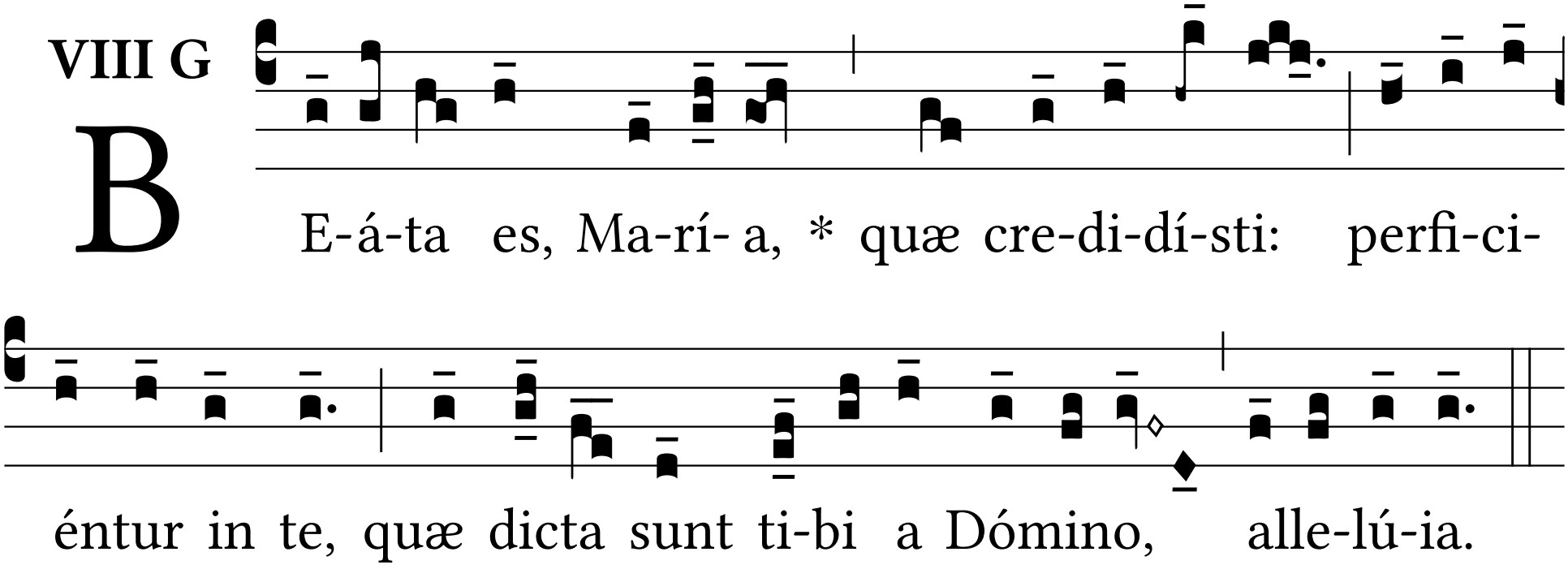
I count 33 long notes (including three double-longs), seven pairs of short notes, and two grace notes, 43 beats. Let's rephrase the question to reflect the historical reality: Does anyone actually believe that, in the antiphon Beata es, lengthening the sixteen short notes to make them equal to the 33 long notes actually improves the chant and renders it more beautiful and musical?
Declarations along the lines of "the rhythmic signs were there to reinforce the natural rhythm arising from the words" are commonplace among semiologists. I have yet to come across a satisfactory explanation from that school about how rhythmic signs within a melisma, especially a long one on a weak syllable, relate to natural speech rhythm.
A friend likes to use the adjectival form Mocquereauvian. I confess, I like it better than Mocquerellian, which is a bit too reminiscent of Machiavellian! -
Here's an example of what I'm talking about:

That's what I would expect from Laon for equal note values for the first line of your first example above. How else could one notate equalist rhythm using the Messine neumes?
On the subject of bar lines: I would be interested to read a history of their origin and development, but frankly, I'm simply not interested enough to research it myself.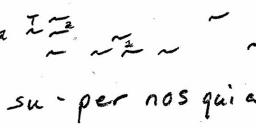
 20240204_Lux fulgebit.jpg2504 x 274 - 79K
20240204_Lux fulgebit.jpg2504 x 274 - 79K -
Dr. Weaver,
Thank you for the book links, they look quite interesting. Unfortunately, I don't know French, so I don't think I'll get any use out of them. Dom Pothier's recording certainly speaks for itself though, and so I have no reason to doubt the conclusion that the rhythm of the Vatican Edition was somewhat ambiguous. The preface is not as crystal clear as some of us would like! I had no success convincing a member of our schola last summer, and I suppose that is because the "proof" I was presenting him didn't actually exist.
Thank you also for you offer to come sing with you sometime. I don't travel much, but if the opportunity ever presents itself, I'd be happy to take you up on your offer! I'm sure the variety would be refreshing.
I will revise my statement on Dom Pothier's use of the adiestematic manuscripts:
Dom Pothier did have access to the earliest manuscripts, but it seems to me that he did not consider them to contain any necessary information found outside of the equalist manuscripts. Unlike current day semiologists, it seems Dom Pothier was content with the rhythmic indications (or lack thereof) in the later manuscripts, regardless of whether he intended an equal or speech based rhythm. Visually, Dom Pothier's editions were a recreation of the late square note manuscripts, (regardless of the theory behind them). Unless I'm missing something, which is quite possiblequarter barline adds no time and no breath
I have taken serious issue with this for a long time. This contradicts the principles of effective notation. If the quarter bar does nothing, it means nothing, and is useless. In the Vatican Edition, it obviously meant something, it meant a little lengthening and a short breath if necessary. With the addition of the rhythmic signs, we are taught that the dot and horizontal episema mean lengthening, not the barlines. So the barlines loss a lot of their original purpose, because now you follow the rhythmic signs, which may or may not agree with the barlines. If you apply a set of consistent rules, it is still a usable notation and can be used to make beautiful music, but I do not think it is ideal.
I concede your point about ambiguity in penultimate syllables. I would lengthen the second note from the end, as Dom Mocquereau indicates. Aesthetically, I take issue with lengthening the i in Maria, as well as dicta and tibi. The rest I don't mind. Perhaps if you have the time and are feeling so generous as to record yourself singing the antiphon, I'll hear the rhythm in a way which I didn't think of singing myself, and perhaps it won't sound bad to me.
Here's unambiguous notation for an equalist reading of the Vatican Edition:
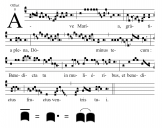
 Ave Maria.png1629 x 1291 - 110KThanked by 1tomjaw
Ave Maria.png1629 x 1291 - 110KThanked by 1tomjaw -
I published my own gradual here and some people think it's too ornamented, my starting point is some greogorian symbols are actually ornamentations (especially porrectus corresponds to trills and gruppettos, climacus corresponds to 16th notes, and torculus to triplet or trills) if one listens to Eastern Catholic/Orthodox Byzantine chant or even islam call to prayer, one can clearly hear such ornamentations. I attached a picture showing the original gregorian chant of the start of Ascension's offertory and my interpretation.
I uploaded the chant mp3 here, because I fixed the problem where embedded firefox player can't play the music. I should untick save meta when saving files in adobe audition
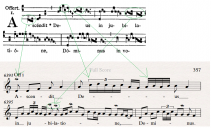
 ascnote.png839 x 508 - 104K
ascnote.png839 x 508 - 104K
 AscenOff.mp39M
AscenOff.mp39M -
Mr. Williams,
I'm by no means suggesting an equalist reading of the adiestematic manuscripts, so you don't have to convince me in that regard. As an experiment, I spent half an hour repeatedly listening to your recording of the gradual Liberasti Nos without looking at the images in the video, and trying to transcribe it without referencing the chant or the genuine neume shapes. Perhaps the results are pathetic, but here it is for your consideration nonetheless. In two of the longer melismas I basically gave up, but perhaps my attempt demonstrates some point. (or nothing!)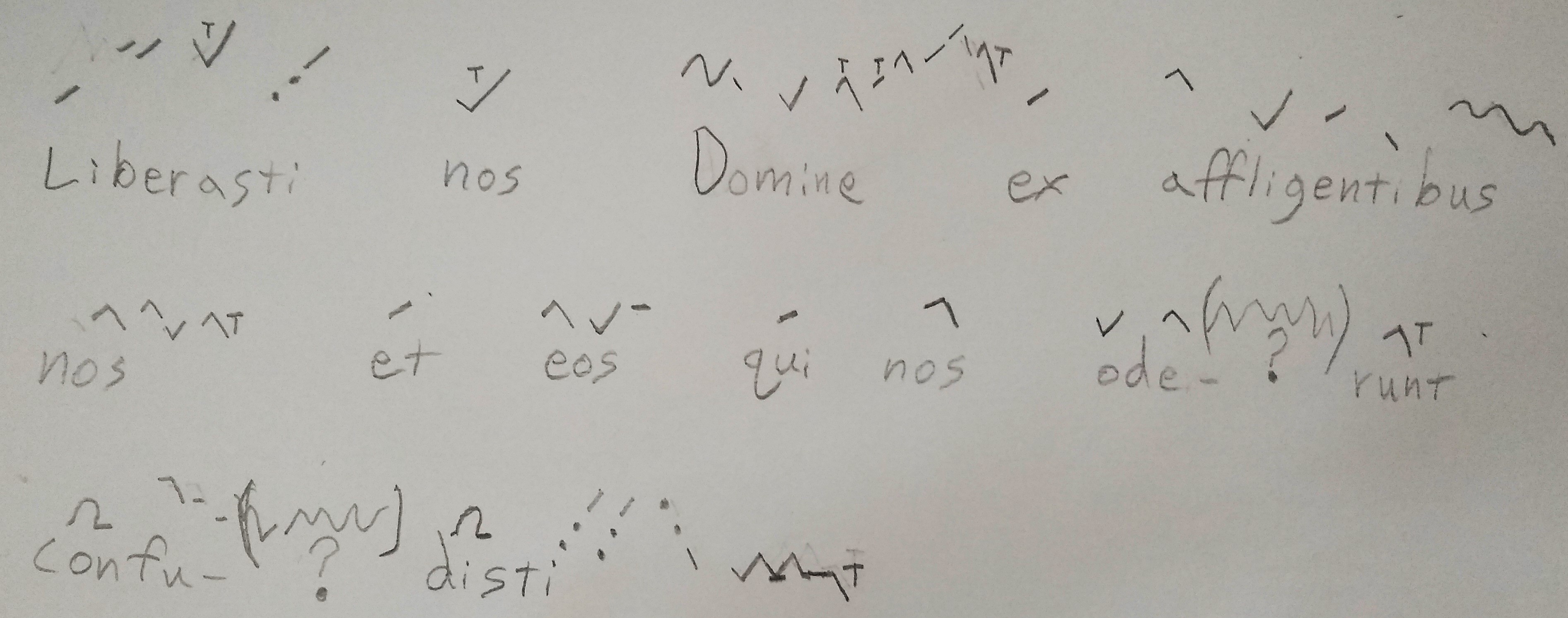
Here is the best I could come up with for a simpler notation. I couldn't figure out how to make hollow diamonds for the grace note. If symbols were designed which did not exist in Gregorio, (say, a visually improved longa and breve) it may be possible to substitute the glyphs in LaTeX. If you have ideas of visuals I would love to give it a try, or I may just stew over it myself.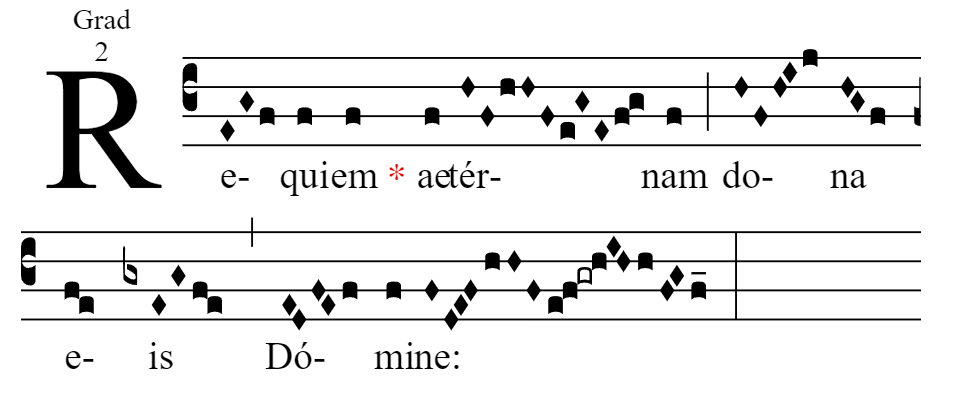
The grace notes bother me slightly, both in the way they are presented, and in how they are to be performed, but perhaps I need to give it more time. On the other hand, if the manuscripts suggest a possible alternative to the grace notes, I would be interested in considering the options, and whether or not something more intuitive could be found.
When the time comes, if you would like help with LaTeX, I would be happy to see what I can do. I have a good basic understanding of how to use it and make books (disagreements about fonts aside!), but for more complex tasks I have gotten help from others on the forum who are real coding wizards. I imagine though that what you're trying to do is pretty simple. Just presenting the information in a sensible way for people to use.
For the antiphon Beata es, I do personally think that lengthening the sixteen short notes to make them all equal improves the chant and makes it more beautiful, as long as the chant is taken at a brisk pace. Otherwise, equalism sounds dreadful if it's too slow.
I see what you're saying about them being all long, not all short, which is true from a historical perspective. But in the method I'm talking about (the sort of equalism advocated by Mr. Ostrowski), it's really not that way. The normal note value is short, and the notes before barlines, qualismas, and MMV are long. If you have shorts, longs, and double longs, and then you get rid of the shorts, the longs become the "short" notes in the system, and the double longs become the long. Short and long are relative.
 Transcription.jpg3788 x 1492 - 797K
Transcription.jpg3788 x 1492 - 797K
 Alternate Notation.png954 x 414 - 33KThanked by 1tomjaw
Alternate Notation.png954 x 414 - 33KThanked by 1tomjaw -
For demonstrative purposes, here's the first line of Ave Maria notated with short values as the norm:

Compare the Novum:
We can only give the Vatican edition a grade of 80% at best as far as the authentic rhythm is concerned. [EDIT: See comment below.]
Thank you for taking the time to make a transcription! A few comments: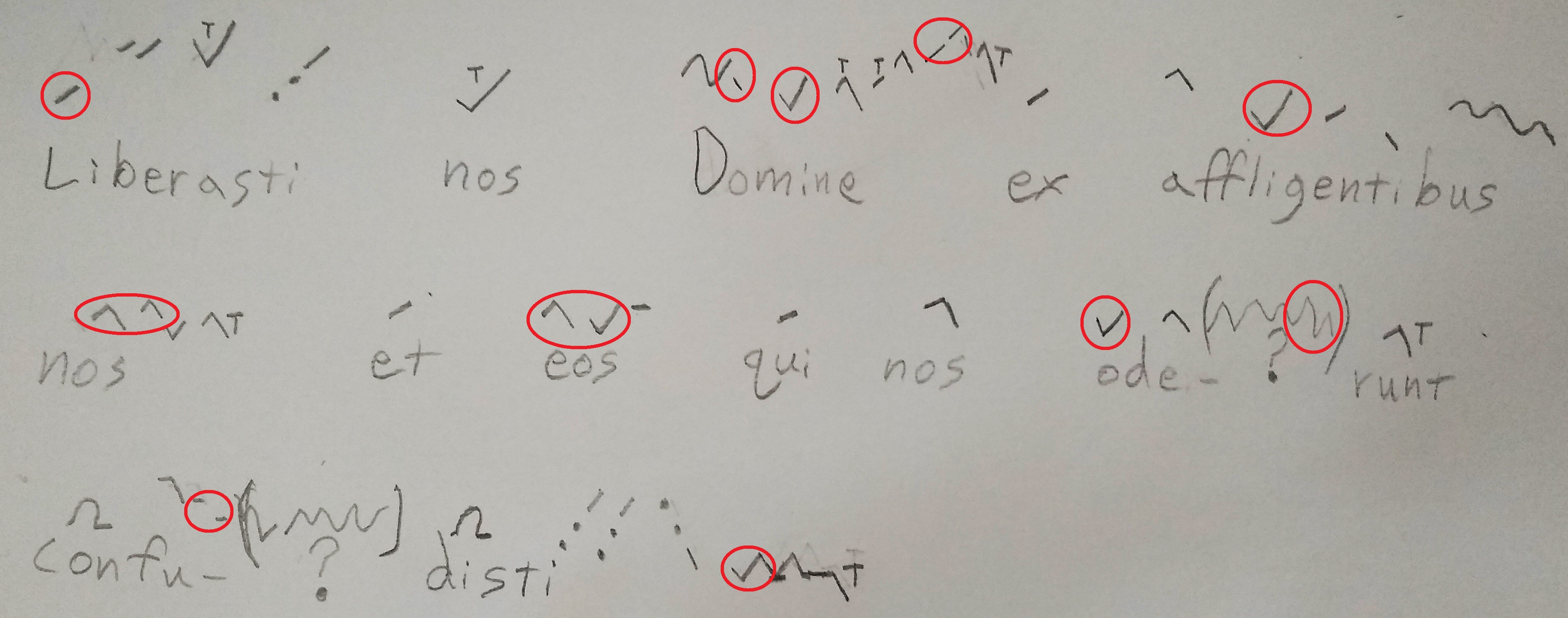
You have written the first note as long. The separation at Do- would imply long notes, and the angular form at -mi-, the pes quadratus, would also be read as long. The circled element at -ne should be a plain torculus. -fli- should be short, the pes rotundus. You have written two identical clives at the second nos, which would imply either four longs or four shorts, but not two longs plus two shorts; there is also a note missing in between. Eos is notated backward and long instead of short. O- should be short, and where is the ascending element (scandicus) of -de-? The beginning of -fu- appears to be short-short-long-long, which isn't accurate. The angular figure at the end would imply longs. It's not an awful attempt though!
As for the Requiem gradual example, I find it perfectly legible. My reservation with it is that the only connected notes are long, and the short notes are all written separately, which is the opposite of the oldest notation. We could try something like this: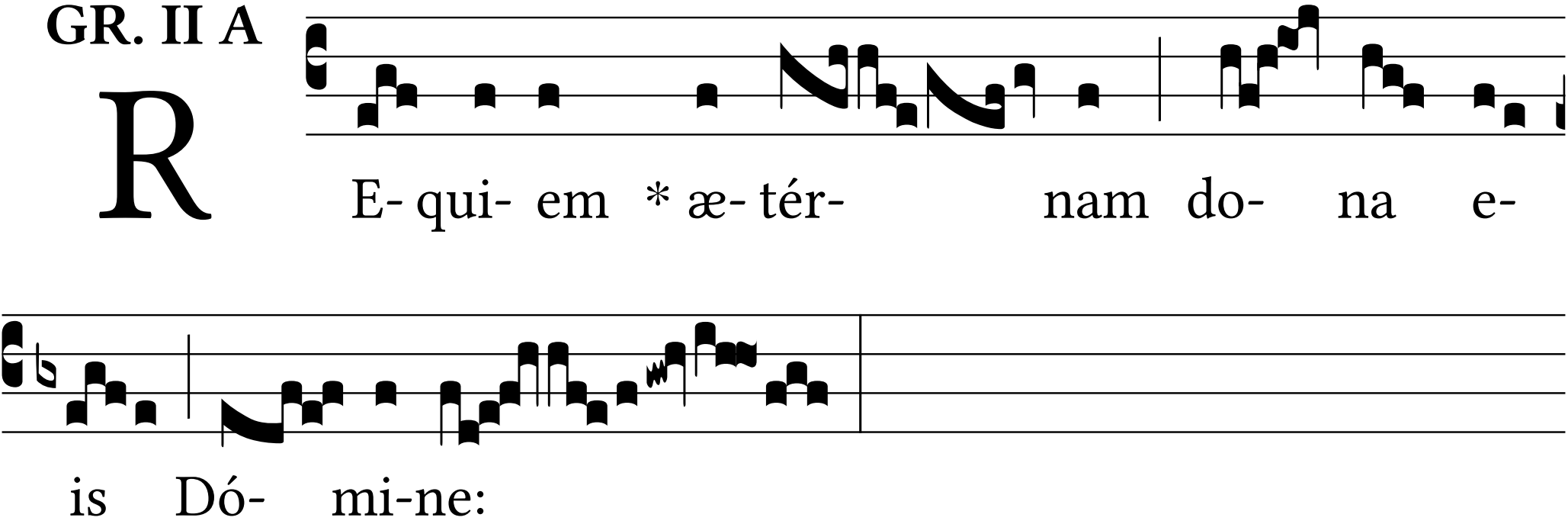
But that's barely different from Royce's edition:
As for the quarter bar lines, I think it's more correct to treat them as optional breaths; whether or not breath is taken, they mark the end of a phrase and the beginning of another. Others will know better, but some of the Solesmes method people insist that you should breathe there only if absolutely necessary and singing alone, otherwise stagger breathe even if there are only two cantors. That approach seems too extreme to me. I might suggest that where a quarter bar line is preceded by a long note (and aren't they all by definition long according to the Vatican edition??), the whole schola might fittingly breathe together if there's a comma in the text, if the bar line follows a word ending in a vowel, or if it's within a melisma.Thanked by 1tomjaw -
Actually, I missed a couple of red marks in my Novum example, at the last note of the first syllable and at the end of -gra-. Now we're at C+ at best for that one line.Thanked by 1tomjaw
-
@weikangcai
Congratulations on completing such a huge project. Although I disagree with the general idea behind your project (which I understand to be soloists singing the Propers in a more ornamented way), I nevertheless wish you the best, and hope your endeavors are fruitful. I am skeptical about the Gregorian symbols being ornamentations in the way you describe, but I'm not the most knowledgeable person myself, so I will leave that debate to others.
Ironically, some people also think my Graduale is too ornamented, but that's more the fonts and visual choices. And admittedly, some of them weren't commenting on the Graduale, just another book in the same style.Thanked by 1tomjaw -
Mr. Williams,
I know it's a habit of yours to color-code the Graduale Novum and make nice visuals showing long and short notes, or discrepancies between different sources, and all that. But in this case it's just beating a dead horse!
I've been clear from the beginning that the equalism I suggest does not agree with the oldest manuscripts, so why keep arguing the point, when there's no disagreement? I like the equalism because it is simple, beautiful (at least to my ears), and intuitive (to me at least). I like free rhythm aesthetically, but I have issues singing much nuance, since as you well know, it quickly becomes nuances of nuances, which is ridiculous.
If I am looking to sing chant according to the oldest manuscripts, I will happily use your editions (or editions based on your editions) any day of the week.
In my transcription of Liberasti, I was paying 80% of my attention to the movement of pitch, and 20% to rhythm. Off the top of my head, I didn't remember what the short forms of the neumes looked like, but I thought the less prepared I was the better the experiment. If I referenced the Triplex (different chants than the one I was listening to), I could copy the actual styles properly from one of the manuscripts. Maybe I'll try it later.
Also, the notation you posted an image of is not at all intuitive. I can't tell the difference between the longs and shorts at all, which is the most important thing.
(edit) actually, now I see that the longs are the end of each neume. I'll have to think about it more.Thanked by 1FSSPmusic -
I didn't mean to belabor the point, but to give an adiastematic example with movement in short notes instead of longs.Thanked by 1OMagnumMysterium
-
This reminds me of some earlier discussions and brings me to new ground. I personally find that the tradition as passed through Fontgombault is consistent, though I know that not everyone shares this opinion, but you can tell that they have dropped emphases (whether this is effectively an episema or is just a crescendo is up to you — I just note in passing that Mocquereau and the Sistine Chapel Choir both agree on the bivirga as a point of emphasis!) particularly on the podatus or clivis, but the first note of the climacus is still typically distinct. The written episemas are observed but are lighter, some just barely present, in comparing the earlier recordings to the 2000s (unfortunately they paused for about a decade, and the newest ones are not online). They’ve recorded Mass X twice, for example. The dynamics are more on the individual neumes than on the phrase, so in other words, arsis doesn’t precisely correspond to rising notes nor to rising volume and vice-versa for thesis — imagine singing Credo I that way… but the phrase is still musical, and they make ample use of slowing down even before quarter bars. The double dotted notes are milked for the fullest possible expression; I learned how to sing psalmody like that with the ICRSP, and I do the same with my schola for Vespers. I add a bit more of dynamics (like when certain mode 1 chants ascend around the halfway point to the flat, as anyone observing Divino Afflatu Vespers had last night in the antiphon Amavit eum, or on the last Sunday per annum in Amen dico vobis).
I went back, and am still going through, the recordings with the copy of the Ordinary that I keep in a binder with protective sheets; as an aside, I could do my own scores, but the ICRSP scores are perfect for chironomy markings. I added notes based on the recordings, and eventually, I’ll just have to get one of the choirmasters to help finish the ones which I can’t glean from recordings! I don’t want it to be a pastiche or mindless, of course. The emphases are sensible particularly where an accent gets lost, though it also cannot, and should not, overly emphasize downbeats. There’s no getting around an ictus that is merely organizational particularly on the last note of a climacus or tristropha where the second beat begins a new syllable as is the case in the Requiem introit, with regards to a descending figure getting an ictus before changing syllables (and many other places!)
I should mention too that for whatever faults are present in the recordings of the proportionally-sung chant, they have aesthetic merit.
Also, I will say: I do wish to know how the musical judgement is informed at Fontgombault and its daughter houses, insofar as these emphases are not random, but it’s not clear to me for the ordinary what could lead to this. My impression is that it’s some sort of reference to the manuscripts for the propers and the office — though it’s a bit daunting, and for Vespers, I just try to sing it naturally and in the way that the group melds unless it’s, well, not working, as one does. :)
*I should note that I find that psalmody is sung with somewhat more attention to dynamics of a phrase as we are used to in modern music. -
Matthew, very interesting comments as always. It seems to me that Denise Lebon and the circle around her must have something to do with this rather interesting style. It would be interesting to hear more of Schola Saint Grégoire's activities. There are pockets of that same tradition here in the states as well, as you and I have both witnessed.
I know for sure that there are a certain extra expressive neumes and other musical indications observed at Fontgombault and the daughter houses, and that these are reported to have come from Dom Gajard through oral tradition. I've never heard that this tradition has extended to the ordinary. -
@OMagnumMysterium
Regarding the quarter barline, you write:I have taken serious issue with this for a long time. This contradicts the principles of effective notation. If the quarter bar does nothing, it means nothing, and is useless.
This is an interesting point. One thing to consider is that unlike Guéranger and Pothier and most of the other people working on the chant restoration, Mocquereau was a trained musician. In modern music, a barline doesn't add time but functions precisely like the quarter barline as interpreted by Mocquereau. It divides the music into discrete sections of a certain length, without having any duration of its own. It is purely organizational. By giving this function to the quarter barline, and then giving the idea of two lengths of rest (single length, longer (or double length), Mocquereau is again rationalizing the system. Why should there be three distinct lengths of rest notated, in addition to the natural mora vocis that happens at the end of every word.
A second thing to consider is what Mocquereau actually says about this, which as usual with Pothier and Mocquereau comes with a rather lengthy paper trail stretching back to the middle ages. It's in the second volume of Le nombre (another reason to learn French!), and he talks about different lengths of time that one might accord to Guido's idea of three levels of mora vocis. Mocquereau basically says that the shortest level is a temporal parallel to the small intervals one experiences when tuning an instrument or when studying a temperament. That is, there might be some amount of time that is natural to take at the small point of division, but its so small that it's not worth notating. The same idea should apply by extension to the smallest barline, since it probably adds a minute amount of time not worth measuring or writing now.
In general, then, I would say that Mocquereau's interpretation makes the chant notation something more like modern notation: all lengths of notes are indicated by the notes themselves and their additions, but the barlines (particularly the quarter barline) go back to having the same primarily organization function they have in modern music. Since the barlines in their current usage in the liturgical books are a modern editorial innovation anyway, perhaps this was a reasonable solution. -
I also note that, and I feel bad for this, it is indeed sa-lú-tem but most people sing it d sá-lu-tem. This comes out in the Fontgombault recordings, so my own scores will get some kind of marking…
-
In this vast topic, a short but dense book published at Solesmes in 2022 may be of great help here. "Le Rythme du Chant Grégorien" by Dom Jacques-Marie Guilmard of Solesmes looks at the essential contributions of Dom Cardine in the practical "performance" of Gregorian Chant. It is founded on the notion of note value as suggested by the ancient adiastematic manuscripts. It is pretty good, but available only in French.
An issue that should be mentioned here is notation. Whereas these ancient manuscripts are concerned mainly with showing the rhythm of the chant, incorporating this into square notation is not that simple since the latter is mainly concerned with pitch. This is where I think a form of fluxus notation is of great practical help if one wishes to sing in a way that is more faithful to the rhythm indicated in these ancient manuscripts particularly St Gall, instead of having to read 2 music notations at the same time such as from the Graduale Triplex. -
Yes, I need to actually purchase Dom Guilmard's book. As an aside, I've heard really nice things about Dom Guilmard, so there you go.
I have a respect for all of these methods, in their own way: duplex or triplex editions, new editions (there are several semiological editions for example), making notes on the chant based on semiology or custom…Thanked by 1tomjaw -
I would be very interested to know if any of the better informed proponents of semiology have written down their ideas of what the different neumes and note values are. I've read most of Dom Cardine's book on semiology, and he talks about the nuems a lot, but I didn't get any clear understanding of the relations between different lengths.
Even if you are saying that there are a variety of different note lengths beyond simple longs and shorts, you have to at least be able to organize them and explain what they are. If you believe in "natural speech rhythm", you have to be able to explain what that means, and also explain the rhythm of neumes in melismas, since speech rhythm cannot apply to an extended melisma.
If semiologists can provide a clear explanation of exactly what each of the elements in the adiestematic manuscripts mean, then we can make a notation which reflects that. Otherwise, semiology is a theoretical science, not a practical science.Thanked by 1M. Jackson Osborn -
I second the recommendation of Dom Guilmard's little book! Matthew, perhaps I showed it to you in California last summer.
To your last question, OMM, there is a bit more really practical stuff from the "mainstream semiology" point of view in languages other than English. But no matter what, you have to be able to separate the paleography/semiology (just reading the signs on the page and gleaning information from them) from the performance practice being advocated. Cardine's book is foundational for the whole field but is probably too discursive to be a simple, practical guide. However, the various tables of neumes, if studied carefully, have an awful lot of explanatory heft. Even playing around with the nabc feature in Gregorio is really useful, especially in conjunction with the versions of Cardine's tables printed in the nabc reference document. Probably the best short book from a semiological point of view I can recommend is Rampi and De Lillo's Nella mente del notatore from 2019.
Actually I would also highly recommend the various mensuralist materials on Cantatorium on learning to read semiology as a matter of distinguishing relative note values. Semiologists and mensuralists generally agree on relative lengths implied by individual signs (i.e., they largely agree on the paleography), even if they are in complete disagreement about whether the resultant durational relationships between sounds are strictly proportional or not.
There are some complications inherent baked into a non-proportionalist semiological approach. You write "Even if you are saying that there are a variety of different note lengths beyond simple longs and shorts, you have to at least be able to organize them and explain what they are." Well, I'm not sure that any of them would consider it that kind of problem to address. In their view, the neumes we have sort of mediate between the sound of the speech as modulated through the melody, and the signs of the neumes variously diminish or augment the value, but they don't do so in nearly as regimented a way as the proportionalists.
As for the problem of applying "speech rhythm" to melismas, there is a forthcoming book (that I helped out with over the last 8 months by doing gabc engraving) that addresses that very question. I hope it will be interesting to all of you, even though the author is quite a bit more skeptical than any semiologist I've ever met about the supposed rhythmic meaning of the neume signs! -
Is it possible to have two lines of chant performed and notated in the various schools of thought so we can all hear the difference?
-
Yes, it would be possible. Although I don't have very good equipment for recording personally, but perhaps that's besides the point. Do you have a particular chant in mind?Thanked by 1francis
-
Patrick has done this before, and I'm sure he could share his very nice video again. It would be good to have a really short example, though, so I just recorded the first two words of the Ave Maria offertory mentioned above in this thread four ways. Attached are three scores (Vatican with no signs, Liber usualis, Graduale triplex). I recorded first the Vatican according to what I know of Pothier, then the Mocquereau method, then my sort of personal semiology, then proportionalist according to Patrick's method. The Mp3 is all four recordings (about twenty seconds each). For both the semiology and the mensuralist I just read from the triplex score.
I have argued elsewhere for pluralism, and what I mean is that I think actually being able to do this for any given chant would be extremely valuable for anyone who wants to understand the issues.

 Ave1.png1502 x 286 - 42K
Ave1.png1502 x 286 - 42K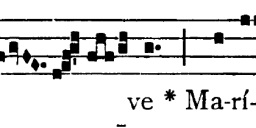
 Ave3.png1082 x 210 - 28K
Ave3.png1082 x 210 - 28K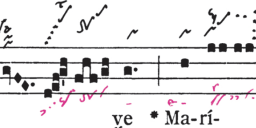
 Ave2.png1668 x 366 - 301K
Ave2.png1668 x 366 - 301K
 ave_maria.mp32M
ave_maria.mp32M -
Very beautiful. I liked the first one the best (aesthetically), although I would have wanted to emphasize the MMV a tad more. But they were all beautiful, and if I remember correctly, presenting all arguments (especially those you disagree with) in the best possible light is something Saint Thomas Aquinas says we should do.
It's a shame I only understand English, because if I could, I would definitely look into the books you've mentioned above, especially the one by Dom Pothier. Do you know of any resources in English which explain how natural speech rhythm works in singing? -
Dr. Weaver, you did show it to us! I've been thinking about it since. By the way, he is teaching a session on rhythm this summer at Solesmes, from the 21st to the 25th (the event is called the "Session de chant grégorien de Solesmes" and seems to be organized by the Association de Musicologie médiévale.
I can attest to this method; am I misremembering, or did Mocquereau or Pothier never sing the same chants one after the other? I can find some of their 1904 demonstrations in Rome (by searching "Dom Pothier Dom Mocquereau 1904" on Youtube), but there, they're singing a series of chants (and I note that there, e.g. in the Assumption introit, Dom Pothier's treatment of the note before quilisma is considerably weaker than what we expect even from Dom Pothier and not Mocquereau; in any case, it's a wonderful demonstration particularly of the Golden Rule in application, where the mora vocis is applied judiciously in between words and therefore at bar lines, but the word is never interrupted for a breath).
As a slight aside, there's a very interesting comment from Fr Z, who is apparently a Cardine disciple and like Mocquereau is a musician.
And as to the traditions, I'm now in the weeds within the traditions. Having thought about it some more, I would argue that recordings are limited but valuable. Even taking into account the technology and the ease of recording an album now, perhaps some of the singing is adjusted for that context, and the degree to which it was adjusted in the past is impossible to know, but I don't have a time machine to go back myself to 1904 or to 1930 (I believe that it's around this point that Solesmes starts issuing LPs under Dom Gajard) and so on. Listening to Mocquereau's "Saceredotes Dei" shows some of the nuance that I associate with Fontgombault, whereas Santo Domingo de Silos sings Gloria XI in a straight way that I consider very beautiful. It is a more literal reading of the neumes and of the signs. I need to get my hands on the CD from Triors which has Mass XI to compare.
OMM, it's good that Dr. Weaver is teaching a class on manuscripts. It's not so good that you'll have to wait to take the rhythm class, but if it comes up again with the CISM at the seminary in Menlo Park, California, do it. (Well, you would probably like the manuscript class too.)
Thanked by 1OMagnumMysterium -
Yes, the principle of charity, or as we might say now, steel-manning, is important, most especially when people get passionate about a disputed subject. What I was trying to do with the MMVs in number 1 was to treat them as a very slight amount of space, like the kind of gap you naturally put between small words when you speak. If you think of the melisma like a sentence, the neumes are the individual words, and the ones with space after them are like groups of words. Anyway, it's very easy to default into the MMVs just being double length. This is actually one of Patrick's strongest points of agreement with Jeff O.!
Anyway, I like all four approaches well enough. I think 3 is probably my favorite here, although I would do 2 with my schola, modified, perhaps, with a few of the niceties from 3.
For speech rhythm, Fr. Columba Kelly did translate the first volume of the big Agustoni & Göschl book into English, but it's expensive and hard to find. It may be possible to get through interlibrary loan. Anyway, speech rhythm as applied to music is notoriously difficult to put into words!Thanked by 1OMagnumMysterium -
A little bit more about "speech rhythm" in melismas. One thing that has occurred to a lot of writers since at least Dom Pothier is that the rhythmic organization of the melismas is probably a lot like the organization of the syllabic chants. There is some relationship between the neumes and the rhetoric of putting a sentence together. This is the same idea as in Notker's practice of turning melodies into texted sequences.
In the case of this first melisma with the MMVs, you might imagine each pitch getting a syllable, like in the attached file. Here I tried at least most of the time to follow Pothier/Mocquereau's principle of the tonic accent, although I didn't come up with anything particularly nice. So you sort of shape the words accordingly, and you space them out from each other and group them in a way that seems sensible. The last step would be to go back to the melisma, and sing it with basically the same shape, except instead of words you get individual neumes.
That's the idea, anyway. Notker's sequences are remarkable because he always observes word breaks between individual neume signs but still manages to come up with really intelligible poetry in process.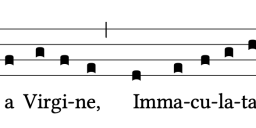
 ave4.png1622 x 292 - 33KThanked by 1OMagnumMysterium
ave4.png1622 x 292 - 33KThanked by 1OMagnumMysterium -
A recording from 2022 is attached. Now I would interpret both of the notes marked with t and long-and-a-half (=dotted quarter). I previously treated the incipit in free rhythm, with the beat not established until gratia. It's not considerably different from the semiological interpretation Charles shared, is it? We use the restored melodic reading, which has sol instead of la at Ma-, and my tempo is slower. He holds the last note of A- a bit longer and doesn't hold the penultimate note of -ri-.
Here's the video of mine that Charles mentioned:

 Ave Maria 20221214.mp3371K
Ave Maria 20221214.mp3371K -
I took it upon myself to put Dr. Weaver's example above into a video for easy examination. Thank you Dr. Weaver for your time and effort. Let me know if this is correct.
http://www.myopus.com/preview/chantComparison.mp4
Personally I favor the first (vatican edition). It is stark and simple and would seem easiest for a schola (with minimal time) to remain together. -
Mr. Williams,
As you have often encouraged, I have been looking at the manuscripts myself this morning, and I am struck by the lack of uniformity between the oldest sources. I wanted to look at the Requiem Gradual, but I was having difficulty finding it in some of the manuscripts, so I used the Gradual Angelis Suis from the first Sunday of Lent for examination instead. Because there were so many images, I put them into a pdf.
One can certainly argue that my transcriptions are bad, and that's probably true, but what really strikes me is the lack of uniformity, comparing the various manuscripts to each other, and then to your edition. The earliest manuscripts don't give just one rhythmic (or melodic) tradition. So if in the ninth and tenth centuries the chant was sung with differing rhythms and pitches in different regions, who are we to say how it was sung in the fifth century, hundreds of years earlier?
I think your work has a lot of musical and historical value, but perhaps you are trying to recreate something which never existed when you speak of "The Authentic
Traditional Rhythm". As history has shown us, chant can shift from being rhythmically differentiated to equal, but it can also shift the other way, from being equal to being rhythmically differentiated.
 Angelis Suis Comparison.pdf684K
Angelis Suis Comparison.pdf684K -
OMM, thank you for posting this. I'm sure Patrick will have much to say, but I just want to make a few comments. For one thing, L has an entirely different melody, which is quite uncommon, but it makes the comparison a little less useful here. Second, all the the manuscripts after that actually have all the melisma on "su-" of "suis." The way they space this is that the melisma just goes up and to the right, while only the tractulus belongs on "-is." Also, I don't know how you are choosing your pitches, but it also makes it a little more difficult to compare. For this kind of work, I think I would prefer to take the pitches from the Vatican and see how the neumes fit.
But the most important thing, which I would encourage you to continue, is that you are onto a really great idea when you try to do the reverse transcription at the end, even though I think you don't do it in the way the manuscripts would suggest. I think this is probably an excellent way to make sure you understand semiology: if these certain notes were long, how would you transcribe it? There are lots of such exercises in that Rampi book I mentioned earlier. There's probably no better way to get a firm grasp on the SG and Laon neumes. I think you don't need nearly so many episemata in your SG, for instance. Anyway, keep at it!Thanked by 1OMagnumMysterium -
Yes. I tend to think there is no way to identify what “authentic” is or was or should now be. IMHO, All of the schools of thought tend toward favoring an artistic interpretation which in the end exhibit very slight nuances from one to the next.
-
Yes, Laon does give a completely different melody, and although I'm sure it's not an extremely common occurrence, I happened to stumble upon it accidentally rather than specifically seeking out such differences. So I think it demonstrates the lack of a single unified tradition.
Now I see what you mean about the tractulus on "-is". I was rather confused by that before. -
I don’t have time this evening to draw up a table of this passage, but I think you are overstating the lack of uniformity. I’m all for skepticism and looking at things from a different point of view, but I do think if you were to arrange and align these neumes over the melody of the Vat, you would find quite an impressive regularity in groupings, as well as a fair amount of agreement in which notes are longer or shorter, especially if you take into account the habits of each individual scribe, which would require a lot of study. I guess I’m suggesting that skepticism in approaching historical sources and theories is good, but don’t just dismiss all the research that scholars have done. This actually tends to support the idea of some kind of rhythmic tradition in the early sources.
In general, I’m as skeptical as you, but I do think it’s healthy to foster a thorough knowledge of what the signs are and what they likely mean.
If I remember, tomorrow I will draw up a bit of a table of this to show you what I mean.
-
The order of MSS listed is approximately chronological. Domine refugium (Pentecost XXI) would better serve your purposes, as Laon uses the same melody as St. Gall there. Note that my edition follows the melodic reading of the Graduale Novum, with occasional exceptions.
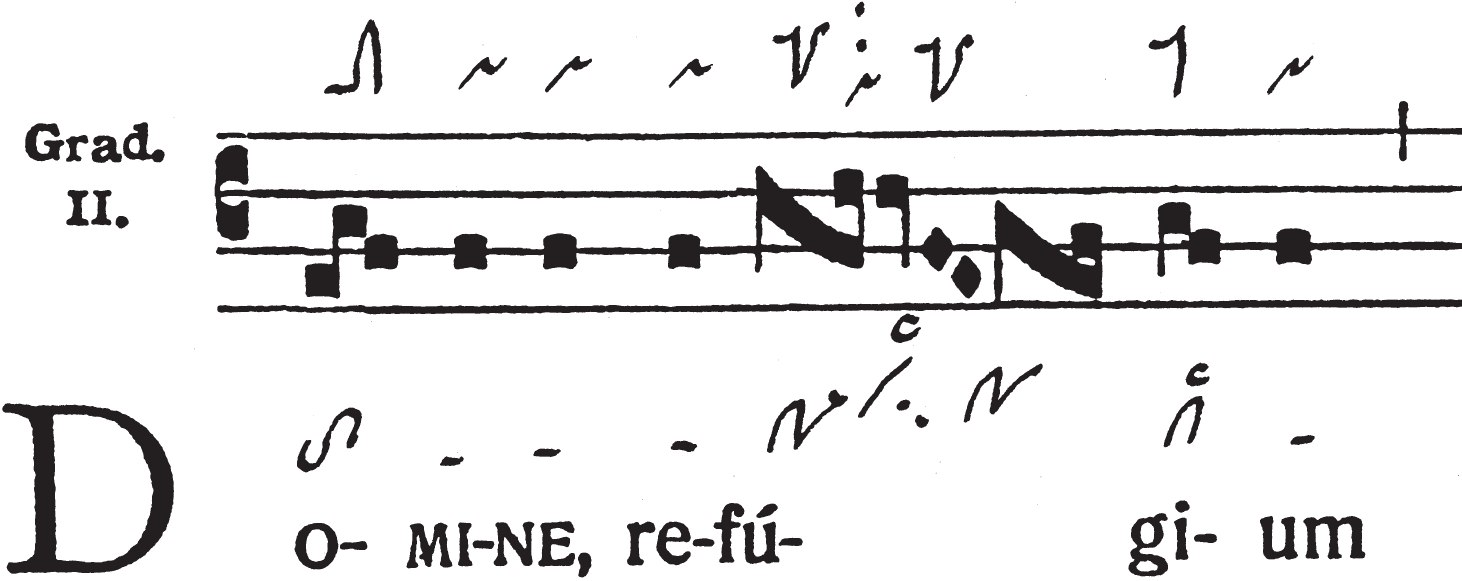
See that the Laon neumes agree with what you transcribed for Angelis suis, without the added t's and the substitution of the clivis at -gi-. Are you still struck by the lack of uniformity? In your transcription of E, you have added extra notes at the beginning of both su- and -is, where you wrote a torculus resupinus each time instead of a porrectus.
B adds an episema at the beginning of -is, where the others don't, but look how Domine refugium is written in the same source:
What's an editor to do? Well, pick one and and go with it! Charles touches on this in his latest CCW post. It's impossible to follow two contradictory readings simultaneously.
I would never venture a guess on how any chant was sung in the fifth century. We have no notated sources from that period, and I have repeatedly emphasized the importance of following the oldest extant sources. That is as close to the authentic traditional rhythm as we can get without more conjecture than I would be comfortable with. But they get us to something singable, and that's the important thing! I have no interest in creating something that never existed. We've had quite enough of that already with at least half a dozen different antimensuralist approaches from Solesmes and elsewhere in just over a century, and now apparently cycling back through them. I'm content with the oldest sources, although I will occasionally deviate from L, especially if Chartres and all of the SG MSS from the 9th–11th centuries give a different reading. Scribes make mistakes, and the scribe of Laon was no more infallible than any other.
Yes, let's hope and pray that chant will shift from being equal to being rhythmically differentiated!!! I'm glad you, too, think it can happen. -
For a very very small percentage of musicians devoted to sacred music this may be a wish that is possible. At the risk of sounding dismissive I will still put this forward. This effort at this particular point in time and in history seems to demand an exponential amount of energy displaced compared to the smaller benefit of it's summary result on both the liturgical milleu and the spiritual landscape of the church that is presently dissolving from within.Yes, let's hope and pray that chant will shift from being equal to being rhythmically differentiated!!!
Could it be invaluable work for a future moment? That is entirely possible. But us musicians in the trenches are just hoping and struggling to keep the dirt out of our firing mechanisms. In other words I don't believe one method over the other will alter the cause of the salvation of souls.
Perhaps a metaphor would be “shall we eat rotten moldy bread out of fine china or just a plain clay pot?” I have said it in the past and I will say it again: I may be completely wrong, but it seems to be along the lines of straining out a gnat and swallowing a camel. Am I the only one that thinks this? If so, I will try to revisit the entire matter again. -
I happen to believe the restoration of chant is worth an exponential amount of energy. It is strange to me that more church musicians don't see it as a priority, but I just have to accept that for what it is. "Not in bread alone doth man live, but in every word that proceedeth from the mouth of God." What is our chant but music—art—crafted from the word of God? Yes, it is rotten and moldy to the extent that its original rhythmic vitality has deteriorated, but I'm not really interested in the rotten moldy bread, whether served in the fine china of a leather-bound Graduale or the plain clay pot of a throwaway missalette. The manna has been well preserved in the oldest sources, and it remains there for our nourishment!
I'm very curious why you say the rhythmic restoration may be possible for "a very very small percentage of musicians." Do you sincerely think nuanced lengthenings (but only one of them in this example) and irregular groupings of two and three notes are easier to learn and sing well than straightforward quarter and eighth notes?
are easier to learn and sing well than straightforward quarter and eighth notes?
If so, why?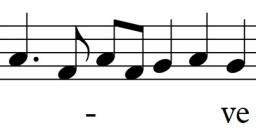
 Ave example.jpg2187 x 202 - 70K
Ave example.jpg2187 x 202 - 70K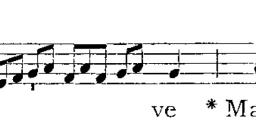
 Ave solesmes.jpg2473 x 325 - 138KThanked by 1francis
Ave solesmes.jpg2473 x 325 - 138KThanked by 1francis -
Recording of this Ave Maria offertory from my graduale. like the previous "Ascendit Deus" it contains extra verses. Note: some notes don't match the solesmes editions. pdf is an excerpt from my graduale

 AdvSun4Off.mp39M
AdvSun4Off.mp39M
 Ave Maria - Full Score.pdf39K
Ave Maria - Full Score.pdf39K -
Ok, attached is a little table showing the four sources you cite of that melody, OMM. I didn't try to beautify the spacing or anything. While there are a couple of discrepancies in terms of which notes are longer etc., there is also quite a bit of agreement. This strikes me as completely normal and also to be expected. An editorial method like, say, just always choosing C when it's a solo chant and E for everything else is completely reasonable.
I don't think it's a good policy to just throw up your hands and say, there must be no rhythmic tradition here so I should do pure equalism. It's a choice, but I don't think it's the best choice. I feel strongly that scholarship, manuscript research, and looking at the sources is a very good thing for chant performers to study.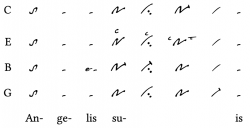
 angelis-table.png902 x 462 - 39KThanked by 1OMagnumMysterium
angelis-table.png902 x 462 - 39KThanked by 1OMagnumMysterium -
@francis
I take your point, but I wonder if the passion some of us feel about this question is not very much augmented rather than diminished in reaction to the problems in the Church. After all, Patrick and I, along with most of the commenters here, are also in the trenches in parishes.
For my part, chant played a big part in my coming back to the faith, and specifically this was the curious beauty and spirituality of the Mocquereau method. Later I studied the other approaches; I do still have a soft spot for the spiritual witness of the writers in the Solesmes orbit. Consider among these Simone Weil, from Gravity and Grace:The beautiful is the experimental proof that the incarnation is possible. Hence all art of the highest order is religious in essence. (That is what people have forgotten today.) A Gregorian melody is as powerful a witness as the death of a martyr.
What a strong idea that is, and what a responsibility for those of us who do it week in and week out! I think a lot of that special quality is not just the melody itself, but also the way the rhythm differs from so much of our mundane musical tasks. I have to do a million other things in my musical life, but there is something set apart about the chanting I do on Sunday mornings, which is as it should be, since I consider Gregorian chant to be a sacramental. That is, it is so special by its nature that it is worth all the fuss, probably way more fuss than any other kind of music would merit.
For this reason, I place a really high value on exploring the rhythmic question in both teaching and performance.
Teaching children by passing on this study of the chant is also passing on the patrimony of the Roman Church. I often find that kids respond well to the little bits of Solesmes/Mocquereau tradition that I pass down to them. I imagine that would be true if I were in a schola geared toward semiology or mensuralism too.
In performing, I think the rhythmic differentiation we make in our schola is extremely important for the beauty of the chant. First, it gives the singers more to think about, more to chew on spiritually; see Gajard's idea that the episema is an invitation to turn within and contemplate the indwelling guest, as I have written about elsewhere. Second, I think our chanting sounds more beautiful for the people in the pews, because we sing it with vitality and interest, drawn from the rhythmic approach. Equalism is fine, but it is also more possible in singing that way to sort of go on autopilot, or to think about the chanting as something to be got through (putting the plain in plainsong). I've been there before.
I'm not saying incorporating the rhythmic study of manuscripts is the only good way to sing chant, but I think it really can help the chant to do its jobs, which are primarily the glorification of God and secondarily the sanctification of the people.
Anyway, that's why I think it's worthy of our study and attention, regardless of which method you follow, even in the present ecclesial climate. -
I think if he had lived longer that he would probably have favored editions such as the semiologists now use.
From the CCW post. Yes. In fact, although it’s hard to attribute the source of these things without going into the archives, we see the Holy Week chants and particularly the Antiphonale Monasticum as departing from the Vatican edition’s frameworks.
Some have gone even further. Mocquereau would have liked, IMHO, what Le Barroux did when typesetting the chant for the patronal office, proper to their house.
Maybe we can say that there are too many episemata here, and it’s a pressus here, not an oriscus — my bad! — but IIRC you see this already in Le Nombre, and yet the official AM doesn’t have this until the 2000s.
Beyond the notation, some of the practical compromises in singing characteristic of Solesmes (the fusions at the pressus for example) can be done away with; I know people who teach and sing according to the Mocquereau system while repeating the note at the pressus! (I don’t always know how I feel about this, as a singer, but so long as it’s clear, I’m fine with it.) -
Yes, Francis, I agree with you, at least for the most part.
When I had talked about chant shifting from equal to rhythmically differentiated, I was talking about the transition from the late medieval chant to the chant used after the Council of Trent.
I suppose as long as one is trying to sing beautifully for God, the exact method doesn't really matter. Just make sure whatever you choose isn't going to cause unnecessary confusion and frustration for your singers. By which I mean, be consistent with your principles so your singers know what to expect.
I have a personal disdain of the Solesmes signs and editions, but it's probably unreasonable of me. I don't even have any control over the music we do at our parish, so I had better just stop spending so much time arguing on the internet, start deflating my pride, and focus on the things I do actually need to be working on in life now.
It's a free country, so Mr. Williams is certainly entitled to spend the "exponential amount of energy" on his new edition, and I pray God will bless his efforts. I still reject the idea of "The Authentic Traditional Rhythm", but I respect his work as being one side of the dice, and frequently consult his website for things such as offertory verses.
I am honored that such knowledgeable people have been willing to take me seriously enough to answer my questions and correct me.
To narrow down the example even further of the mode II graduale, I will offer the following point. It is clear that Mr. Williams (and I am assuming semiologists in general) believe the torculus on the first syllable of the chant is two shorts followed by one long note. There seems to be no indication that the last note is long. When I transcribed the proportional edition using a "T" and an episema, I was using forms found elsewhere in those notations (Laon and St. Gall). If the simple torculus is short-short-long, what are the ones marked with an episema or "T" at the end? -
@MatthewRoth Perhaps the clearest example of Mocquereau thinking this way is in the study on Alleluia Ostende, which appears in PM vol. 10. Attached is a snapshot of the beginning, with his presumably idealized notation.

 Mocquereau_ostende.png1838 x 1330 - 2M
Mocquereau_ostende.png1838 x 1330 - 2M -
OMM, you write: "It is clear that Mr. Williams (and I am assuming semiologists in general) believe the torculus on the first syllable of the chant is two shorts followed by one long note."
I don't think that is the opinion of semiologists in general, but some of them consider the last note of a syllable in a longer group like this to regain its “full syllabic value.” You won’t find this rule in the Guilmard or Rampi books mentioned above. Patrick posted about this some in our discussion at CCW, where I believe he found it in some later Cardine editions.
I think there is probably some value in maintaining a distinction between the cursive torculus and the other forms you mention.Thanked by 1OMagnumMysterium -
The latest CCW Gregorian Rhythm Wars posts have included the opinions that if Mocquereau had lived longer, "he would probably have favored editions such as the semiologists now use" (CW) and that if Cardine were alive today, "I strongly suspect he’d abandon his 'authentic rhythm' theory" (JO). Now to round things out, we need contributors to step up and hypothesize that if they were still around, Murray would surely be a Mocquereauvian and Pothier would be a mensuralist!
The 1983 Liber hymnarius states that the last note of a neume regains the normal syllabic value, i.e., the same value denoted by the horizontal episema, neumatic break, or note before or after a quilisma. According to those rules, the last note of a torculus would be long except where followed by a unison note. I would have to go back and check Cardine's Gregorian Semiology, (I don't have it handy at the moment), but I think he interpreted an ascending neumatic break after a torculus as inexpressive, since the note before the break is lower than both neighboring notes. One of the semiologists here may know better. Laon's equivalent of St. Gall's pes subpunctis is written as torculus+punctum/-a. There, the puncta are considered part of the same neume. https://gregobase.selapa.net/sources/15/15.png
OMM, I recently addressed in another thread why the ordinary cursive torculus is normally short-short-long. To flesh out the evidence a bit more, let's consider the incipit of today's tract. The torculus at -la-, also considered as a scandicus flexus with neumatic break in Cardine's tables and elsewhere, shows no sign of lengthening on its final note, but does it need one to be interpreted as long? The "pure Vatican" equalist and "classic Solesmes" people would say yes. The Cardinian "semiologists" might interpret it as long anyway, in accordance with the 1983 Liber hymnarius rules for interpretation. Compare the tracts Attende caelum, De profundis, Qui regis, and Sicut cervus, where the liquescent form is used. That liquescent scandicus flexus, =tractulus+ancus, is either four notes, LssL, or five, Lssss. There is no argument to be made in favor of reading it as Lsss, yet that is the interpretation being given to the non-liquescent form—and they're all printed as non-liquescents in the Vatican and Solesmes editions. I did come across one instance where an episema was written in St. Gall 342, for the tract Laudate Dominum, but that's exceptional.
Although this is evidence, it is not proof per se. I think the centonization formulae must have been used with rhythmic consistency when the chant was memorized and preserved orally/aurally because it seems improbable that the cantors would have committed a single formula to memory with multiple rhythmic variations for different texts. I cannot prove this anymore than I can prove that there are no ternary rhythmic groupings. This is where common sense and musical intuition factor into the work. As you remind us, it's a free country (although we have international members of the forum!) and others are free to believe that centonization formulae were recalled and transmitted with different rhythmic nuances for each chant (see the uncannily similar quotes from Van Kampen and Olbash here, at the end of the paragraph titled "An Incredible Claim"), that a few ternary groupings were mixed into chants with an otherwise binary rhythm (the paragraph titled "Being Sensible" here), or that an agogic nuance was added to certain notes of office antiphons only at the beginning of a syllable sung to two notes (here). But proof is another matter ;)
Thanked by 1OMagnumMysterium -
This Troyes 522 is interesting. It's a Missal, not just a Graduale.
https://portail.mediatheque.grand-troyes.fr/iguana/www.main.cls?surl=search&p=*#recordId=2.2541 -
FSSPmusicI happen to believe the restoration of chant is worth an exponential amount of energy. It is strange to me that more church musicians don't see it as a priority, but I just have to accept that for what it is. "Not in bread alone doth man live, but in every word that proceedeth from the mouth of God." What is our chant but music—art—crafted from the word of God? Yes, it is rotten and moldy to the extent that its original rhythmic vitality has deteriorated, but I'm not really interested in the rotten moldy bread, whether served in the fine china of a leather-bound Graduale or the plain clay pot of a throwaway missalette. The manna has been well preserved in the oldest sources, and it remains there for our nourishment!
@FSSPmusic
Sorry for my poor analogy.
I think I must reiterate that the level of interest in how you approach chant is commendable and admirable. Do not get me wrong. I was speaking from a pragmatic point of view from one who is a organist, composer, choirmaster, arranger, performer, etc. What it comes down to is I don't have the time or energy to become this granular in the execution of the craft of the chant at this level.
Therefore I default to the more straightforward interpretation of the chant. Personally over the years I have less and less liked the Solemnes method. As I said above I like the beauty in simplicity of the Vatican edition without any markings.I'm very curious why you say the rhythmic restoration may be possible for "a very very small percentage of musicians." Do you sincerely think nuanced lengthenings and irregular groupings of two and three notes are easier to learn and sing well than straightforward quarter and eighth notes?
If so, why?
When one only has 20 minutes per set of Propers to rehearse, unless all the members of the schola are familiar with a particular school of thought, it becomes cumbersome to execute all the material without getting lost in the weeds. The schola I sing with now all practice the Solemnes method. I don't see them rethinking the note values, however, they are becoming less rigid in the 'all notes are the same value' approach, and are starting to think more musically.Charles_Weaver February 11 Thanks
Posts: 31
@francis
...but also the way the rhythm differs from so much of our mundane musical tasks.
Teaching children by passing on this study of the chant is also passing on the patrimony of the Roman Church. I often find that kids respond well to the little bits of Solesmes/Mocquereau tradition that I pass down to them. I imagine that would be true if I were in a schola geared toward semiology or mensuralism too.
I commend you on your efforts! Could you post some recordings of the children?Anyway, that's why I think it's worthy of our study and attention, regardless of which method you follow, even in the present ecclesial climate.
Yes, the difficulties of the moldy bread (which is really the contemporary music that has invaded the liturgy) take over the place of even doing any chant at all, so it becomes a struggle even to do the simplest forms.OMagnumMysterium February 11 Thanks
Posts: 153
Yes, Francis, I agree with you, at least for the most part.
I suppose as long as one is trying to sing beautifully for God, the exact method doesn't really matter. Just make sure whatever you choose isn't going to cause unnecessary confusion and frustration for your singers. By which I mean, be consistent with your principles so your singers know what to expect.
Yes... this is the position I have had to maintain for years with the various scholas under my direction.It's a free country, so Mr. Williams is certainly entitled to spend the "exponential amount of energy" on his new edition, and I pray God will bless his efforts. I still reject the idea of "The Authentic Traditional Rhythm", but I respect his work as being one side of the dice, and frequently consult his website for things such as offertory verses.
Yes. I totally agree. I laud those who can do this work of semiology and I admit it makes me a bit sad inside that I do not have the time or the platform to do so myself.
Thank you all for your expertise.
Welcome to the MusicaSacra Forum!
To participate in the discussions on Catholic church music, sign in or register as a forum member, The forum is a project of the Church Music Association of America.
Categories
- All Discussions21,102
- General Music Discussion8,215
- Job Openings197
- Management of Music Programs850
- Choral Matters533
- Church Documents and Rubrics524
- CMAA Notes302
- Events716
- For Newcomers: Read First26
- Sacred Polyphony546
- Hymnody872
- Gregorian Chant: General2,697
- ↳ Graduale Romanum and Liber Usualis368
- ↳ Graduale Simplex60
- ↳ Semiology63
- Vernacular Plainsong696
- Anglican Use and Anglican Chant68
- Organ, Other Instruments and Repertoire435
- New Composition/Works in Progress1,290
- Recordings230
- Music for Hispanic Ministry159
- Music Education: Children211
- Music Education: General222
- News Items245
- Positions Wanted2
- General Discussion: Catholicism739
- Amusements177
- General Discussion1,033
- Opinions117
